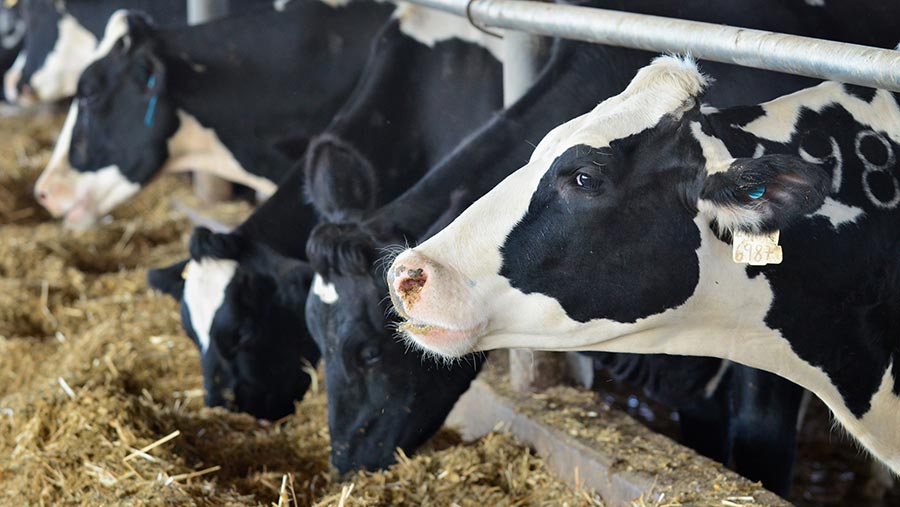Dairies save by cutting ‘safety factor’ protein feeding
 © Rafael Ben Ari/Adobe Stock
© Rafael Ben Ari/Adobe Stock Rationing dairy cows to strict protein levels with no “safety net” is part of a five-step plan by a Northern Irish research team to lower protein in diets as the strategy gathers pace across Europe.
Spearheaded by the heavily regulated Dutch dairy industry, efforts to lower crude protein in dairy rations are aimed at cutting feed costs as well as ammonia and nitrous oxide emissions, say Agri-Food and Biosciences Institute (Afbi) researchers.
Their conclusion follows a fact-finding mission by Afbi on behalf of the Department of Agriculture, Environment and Rural Affairs (Daera) to learn from best practice abroad, including the Netherlands, where farmers have entered into a voluntary agreement to cut crude protein (CP) concentrations to a maximum of 16% by 2024.
See also: Lower-protein dairy feed could cut costs and ammonia emissions
An extra 2-3% metabolisable protein (MP), fed on a “just-in-case” basis, can significantly increase dietary CP, says Afbi. Dutch research shows a 1% drop in CP can reduce ammonia emissions by 10%.
Unveiling five factors to support protein reduction (see “5 lessons from the Dutch nitrogen crisis”), researchers stressed that only 30% of the nitrogen consumed by a dairy cow was turned into milk protein.
5 lessons from the Dutch nitrogen crisis
1. Avoid overfeeding protein
Dutch farmers are being urged to supply the correct amount of protein under a measure known as DVE, which is the digestible protein available in the small intestine (similar to metabolisable protein). No “safety factor” should be fed.
2. Ensure protein and carbohydrates are balanced in the rumen
Dutch nutritionists refer to this as rumen degradable protein balance (OEB). In the past it was recommended that protein was oversupplied, and the ratio was positive in favour of protein. However, it is now accepted that this needs to be close to zero.
3. Feed more glucogenic energy
Glucogenic energy is derived from sugars, starch and digestible fibre, and feeding more increases microbial protein synthesis in the rumen. This increases amino acid uptake from the small intestine and improves protein metabolism. The current advice is to increase glucogenic energy supply as crude protein (CP) is reduced. This must be done while avoiding rumen health issues such as sub-acute rumen acidosis.
4. Accurately test and ration diets
Accurate forage analysis is essential. Modern feeding approaches using metabolisable protein (such as Feed-into-milk in the UK) should be used. Farmers should increasingly move away from CP as a rationing metric.
5. Include maize silage if possible
Maize silage in the diet (30-35% forage dry matter) can help achieve lower protein rations. This can be more challenging with grass or grass-based diets, especially when protein levels in the grass are high.
Source: The work, led by Conrad Ferris and Charlie Sullivan of Afbi’s livestock and production sciences branch, was supported with co-funding by John Thompsons and Son and Trouw Nutrition.
A journey, not a destination
Independent adviser Hefin Richards, of Rumenation Nutrition Consultancy, said accurate rationing and feeding was essential to remove the 1-2% safety net on protein supply.
He added the UK dairy sector had already cut protein from diets, with a drop from 19% to about 16% commonplace over the past 30 years.
But it was important to formulate the ration with metabolisable protein and amino acids in mind, rather than just CP, which was the “very basic assessment of protein based on the nitrogen content of the feed”.
“The industry is on a journey of cutting dietary protein,” Mr Richards told Farmers Weekly.
“Increasingly, this is being driven by environmental factors. When soya was £130/t 15 or 20 years ago, it wasn’t such a worry, but the economic incentive to save on soya when it’s at £550/t is driving more people to look at diets again.”
Getting the right ratio of effective rumen degradable protein (ERDP) to fermentable energy (FME) was like getting the right ratio of fuel to air in an engine, he said.
The other key thing was delivering protein and energy together – achieving “synchrony” – rather than feeding energy between two feeds of protein a day.
“If this happens, we should get much better protein utilisation and be able to feed less protein as a result, leading to lower costs, fewer environmental impacts and potentially improved animal health.”
He gave the following guidance for considering lowering protein in the diet:
- Balance high-protein silages and legumes with energy sources such as maize, cereals or beet/molasses. In a total mixed ration, protein sources might include rape, distillers’ grains, soya and urea-based liquids, which need balancing with cereals, maize silage and beet pulp.
- Maize-based diets with high energy will often allow lower protein feeding, as the starch helps capture the protein.
- Protected amino acid sources may be required to address limiting amino acids, rather than increasing overall total protein supply. The first limiting amino acid is methionine, so assess what is missing, as it may be cost-effective to address it in isolation.
- Make environmental and economic savings. Soya has been trading at about £500t for just over 50% protein, so 1kg of soya protein costs about £1.
- If supplementing grazed grass, protein should be lowered to minimise the oversupply – the protein content of grass can fluctuate from below 16% to 26% or more.
- Grazing situations are inherently challenging, but regular grass analysis can allow a farm to feed a 12% CP cake, rather than a 17% cake, for example.
- Use milk urea data to monitor protein utilisation, particularly when diets change with clamps or seasons. Optimal urea content in milk used to be 250-350mg/litre, but farms should now aim for 140-220mg/litre.
- As you increase glucogenic energy in the diet to increase microbial protein synthesis, consider lactation length and lactation stage. Low-yielding cows with excess energy will get fat, but fresher cows may give more milk.
